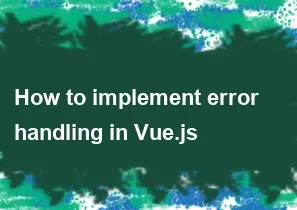How to implement error handling in Vue.js

Error handling in Vue.js is an essential aspect of building robust and reliable applications. There are various ways to implement error handling in Vue.js. Here are some common approaches:
Global Error Handling with Vue.config.errorHandler: You can use the
Vue.config.errorHandlerto define a global error handler. This function will be called whenever an uncaught error occurs in any component.javascriptVue.config.errorHandler = function (err, vm, info) { // Handle the error console.error('Error:', err, 'VM:', vm, 'Info:', info); };Error Capturing with
errorCapturedLifecycle Hook: Components have anerrorCapturedlifecycle hook that allows you to capture errors in the child components. This hook is called when an error occurs in any child component.javascriptexport default { errorCaptured(err, vm, info) { // Handle the error console.error('Error:', err, 'VM:', vm, 'Info:', info); // Return false to stop propagation to the global error handler return false; }, };Using
try-catchBlocks: You can use standard JavaScripttry-catchblocks to handle errors within a specific method or lifecycle hook.javascriptmethods: { fetchData() { try { // Code that might throw an error } catch (error) { // Handle the error console.error('Error:', error); } }, },Axios Interceptors for API Requests: If you are using Axios for making HTTP requests, you can use interceptors to handle errors globally for all your API requests.
javascript// Add a response interceptor axios.interceptors.response.use( response => response, error => { // Handle error console.error('API Error:', error); return Promise.reject(error); } );Using a Plugin for Notification: You can use a notification plugin like Vue Toasted or Vue Notification to display user-friendly error messages.
javascript// Example using Vue Toasted import Toasted from 'vue-toasted'; Vue.use(Toasted, { position: 'top-center', duration: 3000, }); // Usage this.$toasted.error('An error occurred!');
-
Popular Post
- How to optimize for Google's About This Result feature for local businesses
- How to implement multi-language support in an Express.js application
- How to handle and optimize for changes in mobile search behavior
- How to handle CORS in a Node.js application
- How to use Vue.js with a UI framework (e.g., Vuetify, Element UI)
- How to configure Laravel Telescope for monitoring and profiling API requests
- How to create a command-line tool using the Commander.js library in Node.js
- How to implement code splitting in a React.js application
- How to use the AWS SDK for Node.js to interact with various AWS services
- How to use the Node.js Stream API for efficient data processing
- How to implement a cookie parser middleware in Node.js
- How to implement WebSockets for real-time communication in React
-
Latest Post
- How to implement a dynamic form with dynamic field styling based on user input in Next.js
- How to create a custom hook for handling user interactions with the browser's device motion in Next.js
- How to create a custom hook for handling user interactions with the browser's battery status in Next.js
- How to implement a dynamic form with dynamic field visibility based on user input in Next.js
- How to implement a dynamic form with real-time collaboration features in Next.js
- How to create a custom hook for handling user interactions with the browser's media devices in Next.js
- How to use the useSWRInfinite hook for paginating data with a custom loading indicator in Next.js
- How to create a custom hook for handling user interactions with the browser's network status in Next.js
- How to create a custom hook for handling user interactions with the browser's location in Next.js
- How to implement a dynamic form with multi-language support in Next.js
- How to create a custom hook for handling user interactions with the browser's ambient light sensor in Next.js
- How to use the useHover hook for creating interactive image zoom effects in Next.js